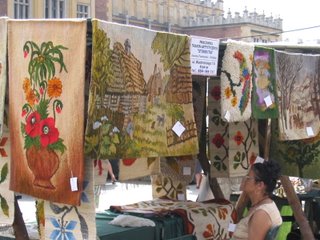What, exactly, is a kilim?
Since I devoted my last post to something I like and enjoy buying and collecting, we'll switch agendas, and I'll share a craft I admire and would enjoy in my home, but cannot begin to afford!
The word kilim is not exclusively a Polish word. It refers to woven rugs, as opposed to tied rugs with some kind of nap to them, and is used in many languages. Of course, "rugs" isn't really the proper word to use in English. I think "tapestry" better conveys the idea. You aren't going to want to walk on one of these.

The tapestries are woven of wool, or sometimes other organic material, on a loom like this one. When I took the picture, the demonstrators hadn't set it up. I saw it later with many colorful hanks of wool arranged on top of it, and still later it was set up with 3 small tapestries on the loom, side by side, all being made in the same pattern. I neglected to take pictures! And I never did see anyone actually working on it, but it is usually a woman.

There are three basic styles of tapestries that I generally see. The first picture above is one style. It is made of some type of agricultural fibers, not wool, and has a folksy, fairy-tale look to it. The second style is sort of square--the patterns are made according to a grid--and represent Polish cultural symbols, including important buildings or city scapes, traditional legends or characters, or heraldic signs. Occasionally you will see some patterns from nature, such as leaves or flowers, done in this blocky style. (If you look closely at the pictures, you can spot some done in this style.)

The third style, and the one most appealing to me, is much more free-form and artistic. Some of these tapestries look like Monet paintings. I don't know that I've ever seen the same pattern copied over and over (as in the case of the folk patterns), but I can't say for sure that each one is entirely unique.

Nevertheless, these are the ones that I find most attractive, and I would certainly like to be able to purchase one to display in my home. However, the prices are well beyond my means. A small, artistic tapestry can cost a few hundred dollars, and I have seen prices that reach well over $1,000. You can sometimes find very small tapestries for under $100, but "very small" and "tapestry" just don't work well together for me.

So year after year, I admire the tapestries, some of which are truly breathtaking. The one I saw this year that most impressed me (not pictured here) was done in wintery colors, and depicted birds sitting on bare branches. Like wonderful paintings, these special tapestries convey a mood and would add a lot to any room in which they hung. Don't you see something here that you'd just love to hang on your wall?

0 Comments:
Post a Comment
Subscribe to Post Comments [Atom]
<< Home